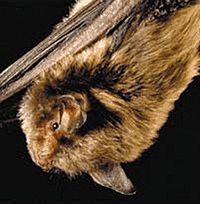
Photo from wikipedia
The control of medically important container-inhabiting mosquitoes is an ongoing challenge for mosquito control operations. Truck-mounted application equipment is a common option for rapid areawide larvicide deployment utilized by mosquito… Click to show full abstract
The control of medically important container-inhabiting mosquitoes is an ongoing challenge for mosquito control operations. Truck-mounted application equipment is a common option for rapid areawide larvicide deployment utilized by mosquito control operations. We tested the effectiveness of two truck-mounted sprayers (A1 Super Duty + Buffalo Turbine CSM3), for the deployment of water-dispersible biopesticides (VectoBac WDG:VectoLex WDG 50:50). Sixty residences within four residential neighborhoods in New Jersey were treated in 2019 and 2020. Three empty bioassay cups were placed in specific locations on each property (front yard/ back yard/ side of house), with an additional cup placed in an adjacent catch basin. This approach was replicated in two untreated control neighborhoods. Following larvicide application, cups were subjected to bioassays wherein larval mortality was tracked through adult eclosion. Overall, average larval mortality rates were 56% higher in treated cups compared against untreated controls. Mortality rates were affected by cup location, with 39% mortality in bioassay cups from back yards, 54% in those from the sides of houses, 73% in front yards, and 76% from cups in catch basins. Mortality did not differ significantly between the four treated neighborhoods, nor by the type of sprayer used. Our research shows that truck-mounted sprayers can be an effective method for larvicide deployment in residential neighborhoods, but effectiveness may depend upon the location of the target treatment area in relation to residences and other geographic obstacles.
Journal Title: Journal of medical entomology
Year Published: 2022
Link to full text (if available)
Share on Social Media: Sign Up to like & get
recommendations!